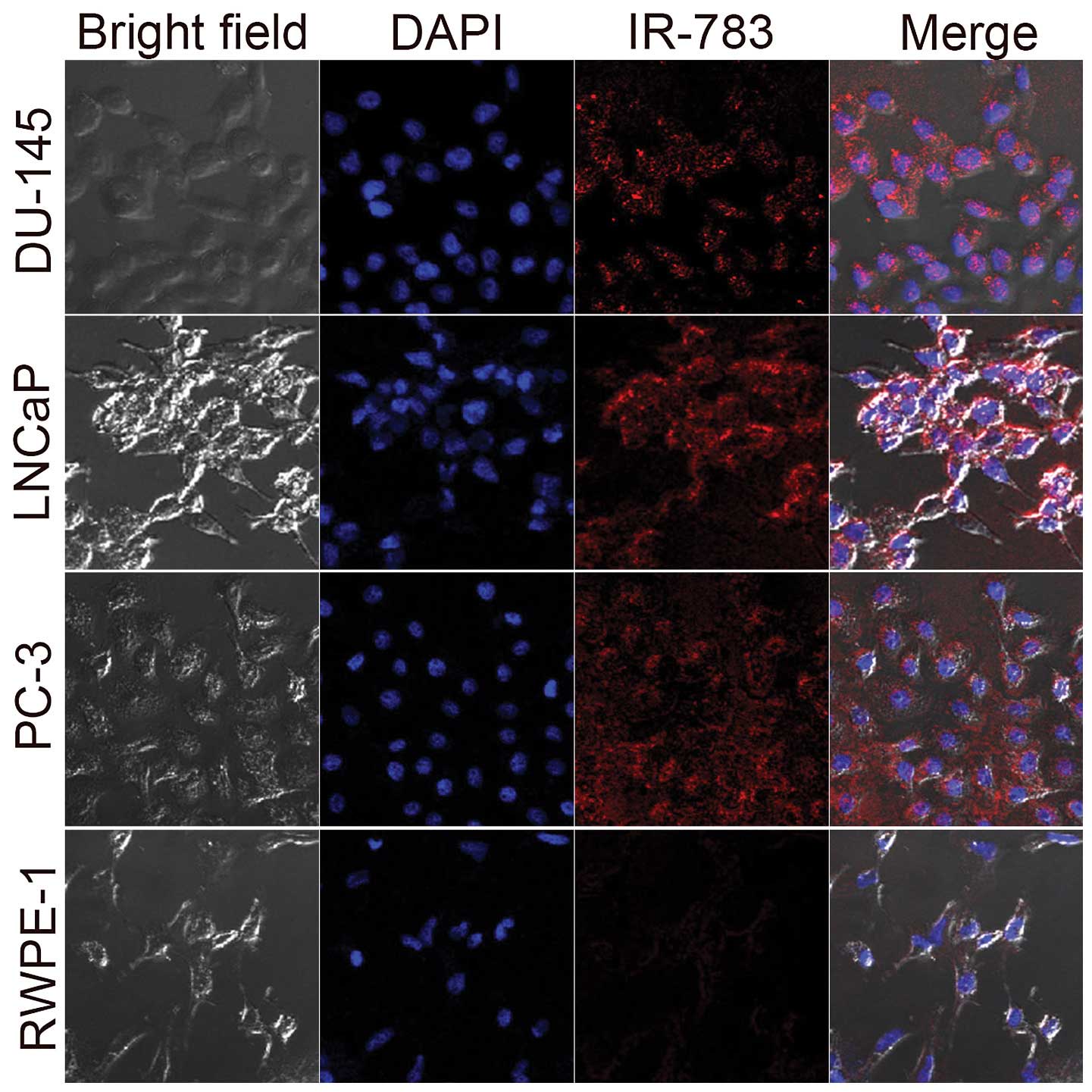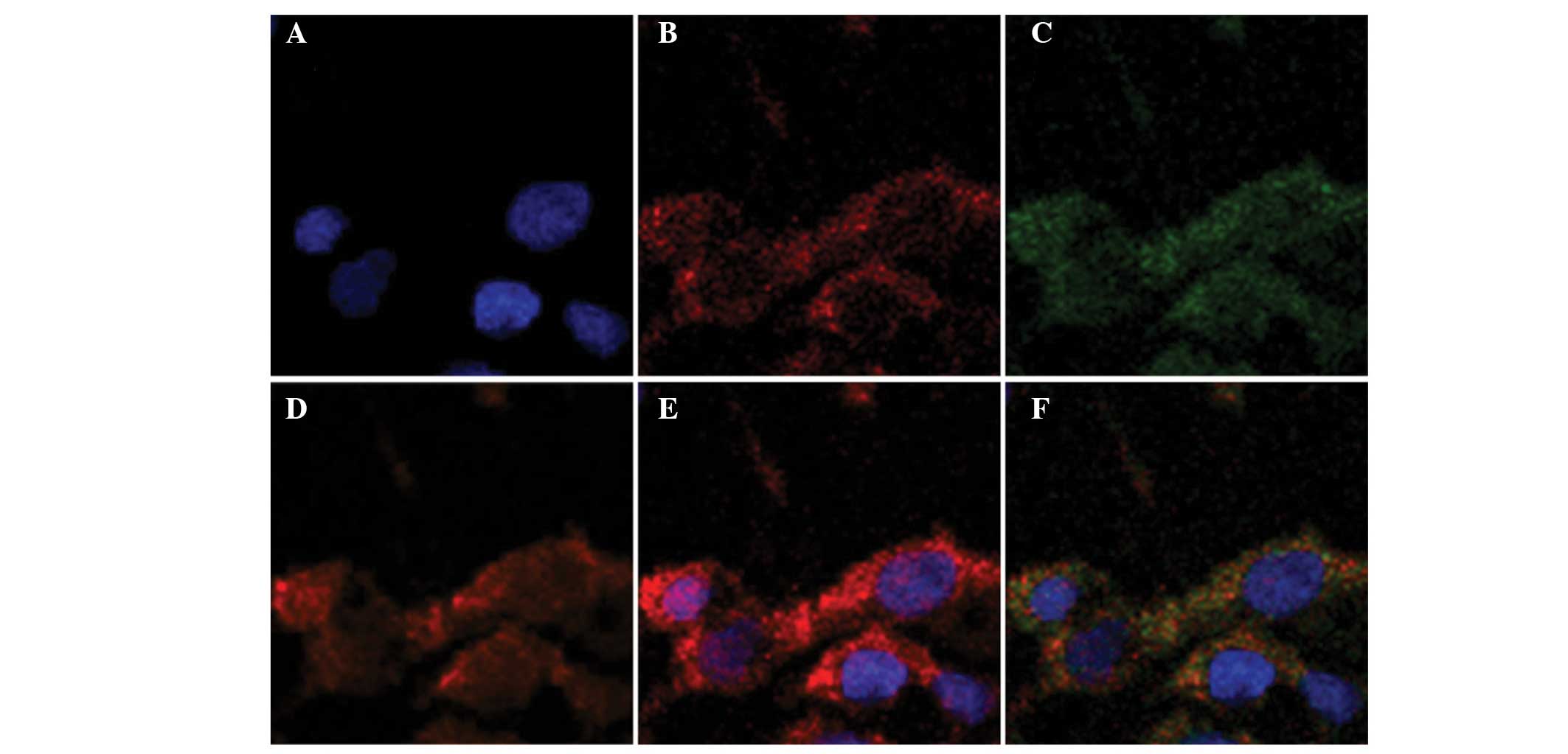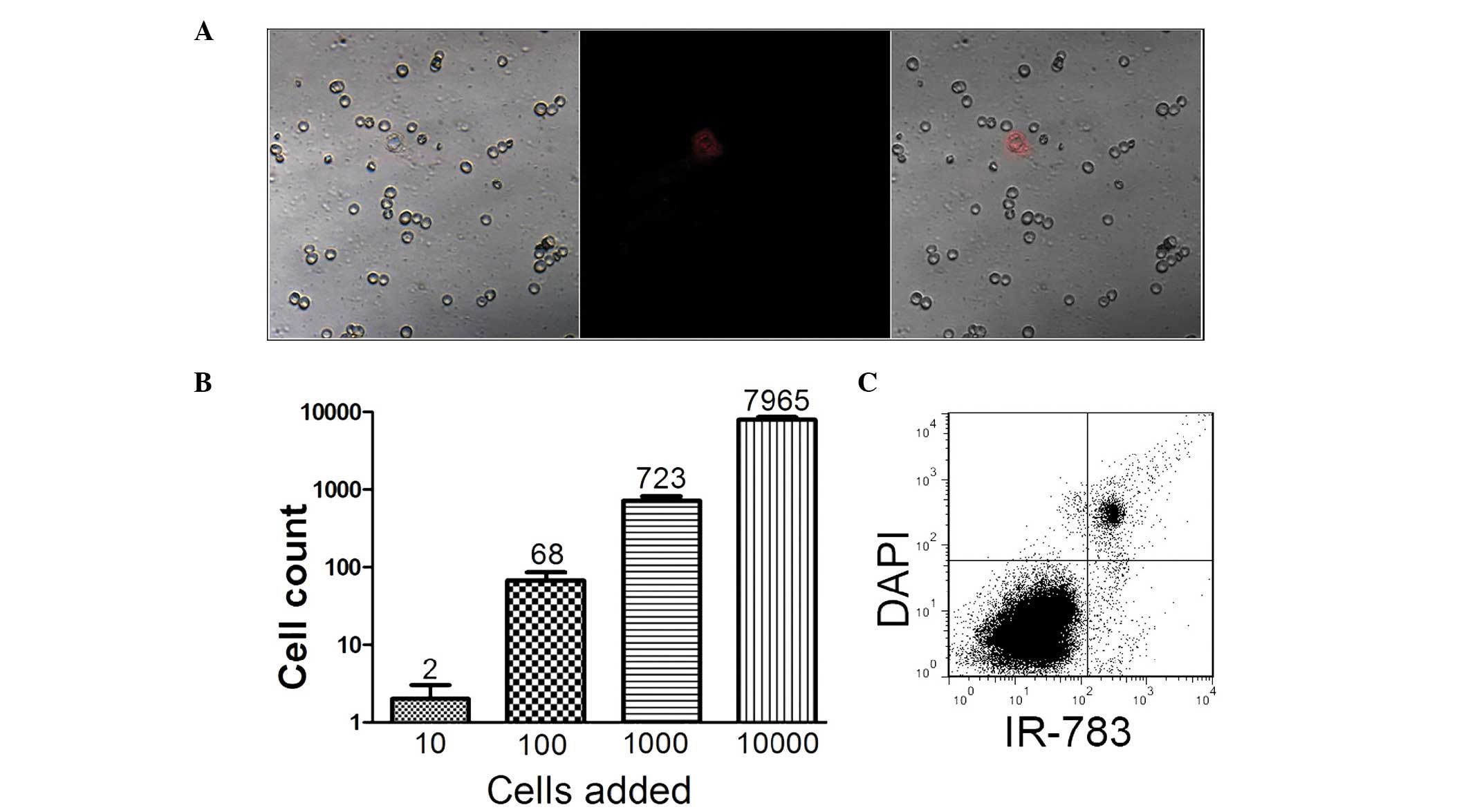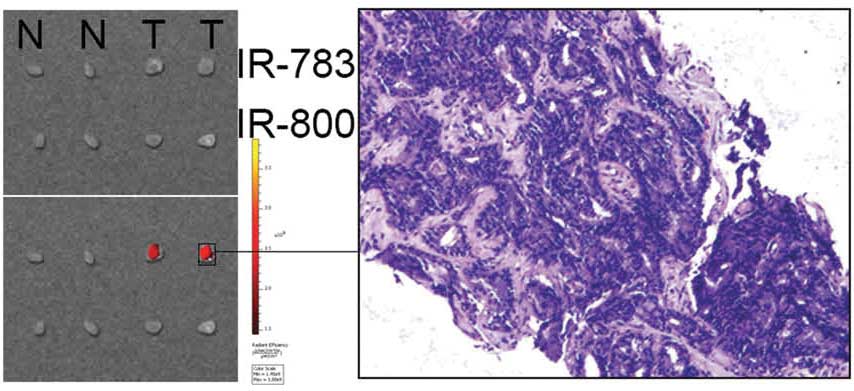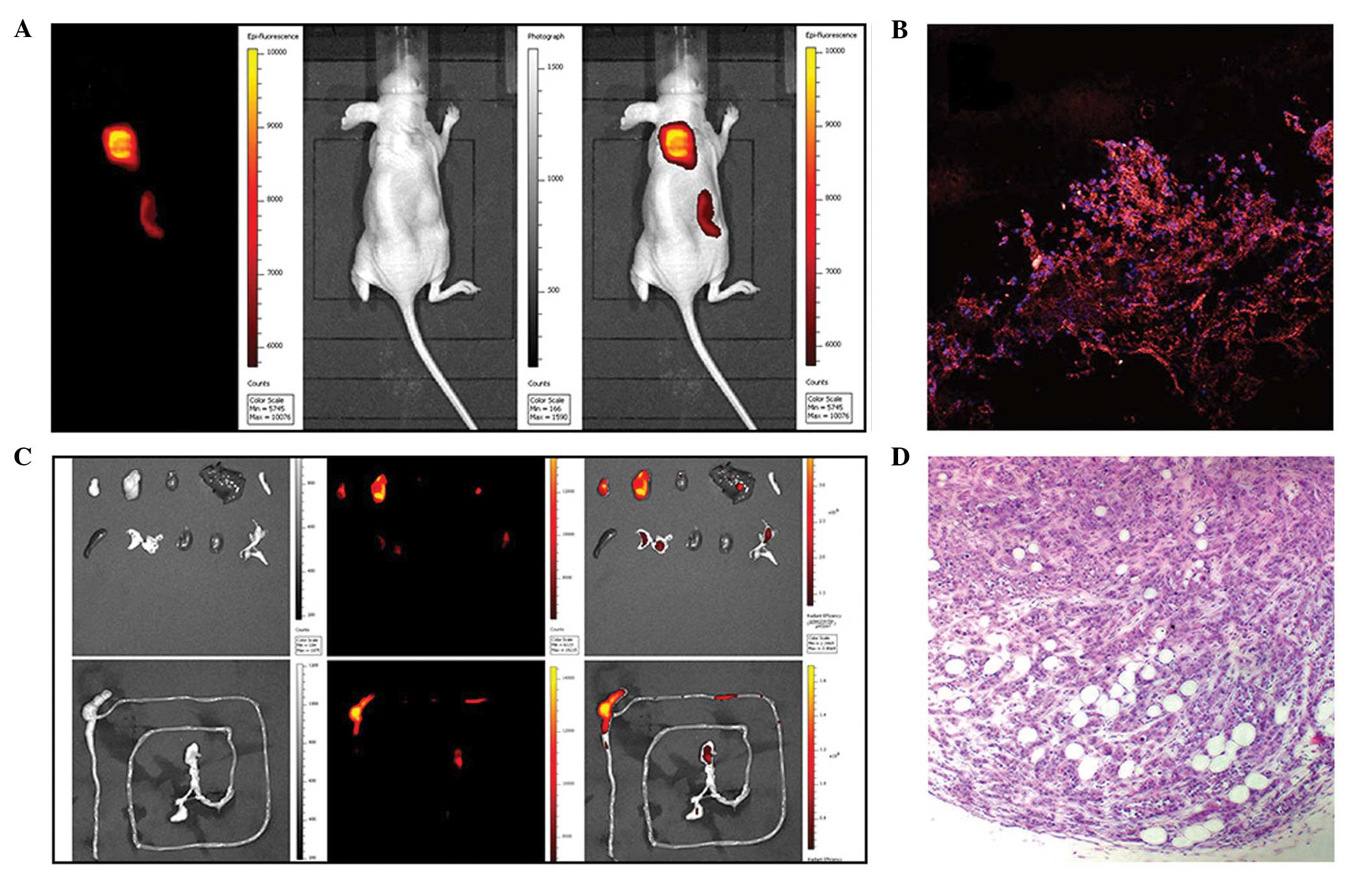|
1
|
Siegel R, Ma J, Zou Z and Jemal A: Cancer
statistics, 2014. CA Cancer J Clin. 64:9–29. 2014. View Article : Google Scholar : PubMed/NCBI
|
|
2
|
Cai QY, Yu P, Besch-Williford C, et al:
Near-infrared fluorescence imaging of gastrin releasing peptide
receptor targeting in prostate cancer lymph node metastases.
Prostate. 73:842–854. 2013. View Article : Google Scholar : PubMed/NCBI
|
|
3
|
Osborne JR, Akhtar NH, Vallabhajosula S,
Anand A, Deh K and Tagawa ST: Prostate-specific membrane
antigen-based imaging. Urol Oncol. 31:144–154. 2013. View Article : Google Scholar
|
|
4
|
Yi X, Wang F, Qin W, Yang X and Yuan J:
Near-infrared fluorescent probes in cancer imaging and therapy: an
emerging field. Int J Nanomedicine. 9:1347–1365. 2014. View Article : Google Scholar : PubMed/NCBI
|
|
5
|
Yang X, Shao C, Wang R, et al: Optical
imaging of kidney cancer with novel near infrared heptamethine
carbocyanine fluorescent dyes. Journal Urol. 189:702–710. 2013.
View Article : Google Scholar
|
|
6
|
Svoboda M, Riha J, Wlcek K, Jaeger W and
Thalhammer T: Organic anion transporting polypeptides (OATPs):
regulation of expression and function. Curr Drug Metab. 12:139–153.
2011. View Article : Google Scholar : PubMed/NCBI
|
|
7
|
Obaidat A, Roth M and Hagenbuch B: The
expression and function of organic anion transporting polypeptides
in normal tissues and in cancer. Annu Rev Pharmacol Toxicol.
52:135–151. 2012. View Article : Google Scholar :
|
|
8
|
Hamada A, Sissung T, Price DK, et al:
Effect of SLCO1B3 haplotype on testosterone transport and clinical
outcome in caucasian patients with androgen-independent prostatic
cancer. Clin Cancer Res. 14:3312–3318. 2008. View Article : Google Scholar : PubMed/NCBI
|
|
9
|
Shimizu Y, Temma T, Hara I, et al:
Micelle-based activatable probe for in vivo near-infrared optical
imaging of cancer biomolecules. Nanomedicine. 10:187–195. 2014.
View Article : Google Scholar
|
|
10
|
Chen Q, Wang C, Cheng L, He W, Cheng Z and
Liu Z: Protein modified upconversion nanoparticles for
imaging-guided combined photothermal and photodynamic therapy.
Biomaterials. 35:2915–2923. 2014. View Article : Google Scholar : PubMed/NCBI
|
|
11
|
Zhang E, Luo S, Tan X and Shi C:
Mechanistic study of IR-780 dye as a potential tumor targeting and
drug delivery agent. Biomaterials. 35:771–778. 2014. View Article : Google Scholar
|
|
12
|
Yang X, Shi C, Tong R, et al: Near IR
heptamethine cyanine dye-mediated cancer imaging. Clin Cancer
Research. 16:2833–2844. 2010. View Article : Google Scholar
|
|
13
|
Ismair MG, Stieger B, Cattori V, et al:
Hepatic uptake of cholecystokinin octapeptide by organic
anion-transporting polypeptides OATP4 and OATP8 of rat and human
liver. Gastroenterology. 121:1185–1190. 2001. View Article : Google Scholar : PubMed/NCBI
|
|
14
|
Karlgren M, Vildhede A, Norinder U, et al:
Classification of inhibitors of hepatic organic anion transporting
polypeptides (OATPs): influence of protein expression on drug-drug
interactions. J Med Chem. 55:4740–4763. 2012. View Article : Google Scholar : PubMed/NCBI
|
|
15
|
Gui C, Wahlgren B, Lushington GH and
Hagenbuch B: Identification, Ki determination and CoMFA analysis of
nuclear receptor ligands as competitive inhibitors of
OATP1B1-mediated estradiol-17beta-glucuronide transport. Pharmacol
Res. 60:50–56. 2009. View Article : Google Scholar : PubMed/NCBI
|
|
16
|
He W, Kularatne SA, Kalli KR, et al:
Quantitation of circulating tumor cells in blood samples from
ovarian and prostate cancer patients using tumor-specific
fluorescent ligands. International J Cancer. 123:1968–1973. 2008.
View Article : Google Scholar
|
|
17
|
Yi X, Zhang G and Yuan J: Renoprotective
role of fenoldopam pretreatment through hypoxia-inducible
factor-1alpha and heme oxygenase-1 expressions in rat kidney
transplantation. Transplant Proc. 45:517–522. 2013. View Article : Google Scholar : PubMed/NCBI
|
|
18
|
Valentim AM, Alves HC, Olsson IA and
Antunes LM: The effects of depth of isoflurane anesthesia on the
performance of mice in a simple spatial learning task. J Am Assoc
Lab Anim Sci. 47:16–19. 2008.PubMed/NCBI
|
|
19
|
Wu TT, Sikes RA, Cui Q, et al:
Establishing human prostate cancer cell xenografts in bone:
induction of osteoblastic reaction by prostate-specific
antigen-producing tumors in athymic and SCID/bg mice using LNCaP
and lineage-derived metastatic sublines. Int J Cancer. 77:887–894.
1998. View Article : Google Scholar : PubMed/NCBI
|
|
20
|
Yuan A, Wu J, Tang X, Zhao L, Xu F and Hu
Y: Application of near-infrared dyes for tumor imaging,
photothermal, and photodynamic therapies. J Pharm Sci. 102:6–28.
2013. View Article : Google Scholar
|
|
21
|
Buxhofer-Ausch V, Secky L, Wlcek K, et al:
Tumor-specific expression of organic anion-transporting
polypeptides: transporters as novel targets for cancer therapy. J
Drug Deliv. Feb 3–2013.(Epub ahead of print). View Article : Google Scholar : PubMed/NCBI
|
|
22
|
Wright JL, Kwon EM, Ostrander EA, et al:
Expression of SLCO transport genes in castration-resistant prostate
cancer and impact of genetic variation in SLCO1B3 and SLCO2B1 on
prostate cancer outcomes. Cancer Epidemiol Biomarkers Prev.
20:619–627. 2011. View Article : Google Scholar : PubMed/NCBI
|
|
23
|
Shao C, Liao CP, Hu P, et al: Detection of
live circulating tumor cells by a class of near-infrared
heptamethine carbocyanine dyes in patients with localized and
metastatic prostate cancer. PloS On. 9:e889672014. View Article : Google Scholar
|
|
24
|
Tjensvoll K, Nordgård O and Smaaland R:
Circulating tumor cells in pancreatic cancer patients: Methods of
detection and clinical implications. Int J Cancer. 134:1–8. 2014.
View Article : Google Scholar
|
|
25
|
Thalgott M, Rack B, Maurer T, et al:
Detection of circulating tumor cells in different stages of
prostate cancer. J Cancer Res Clin Oncol. 139:755–763. 2013.
View Article : Google Scholar : PubMed/NCBI
|
|
26
|
Hellebust A and Richards-Kortum R:
Advances in molecular imaging: targeted optical contrast agents for
cancer diagnostics. Nanomedicine (Lond). 7:429–445. 2012.
View Article : Google Scholar
|
|
27
|
Fomina N, McFearin CL, Sermsakdi M,
Morachis JM and Almutairi A: Low power, biologically benign NIR
light triggers polymer disassembly. Macromolecules. 44:8590–8597.
2011. View Article : Google Scholar : PubMed/NCBI
|
|
28
|
Muselaers CH, Stillebroer AB, Rijpkema M,
et al: Optical imaging of renal cell carcinoma with anti-carbonic
anhydrase IX monoclonal antibody girentuximab. J Nucl Med.
55:1035–1040. 2014. View Article : Google Scholar : PubMed/NCBI
|
|
29
|
Cheng K and Cheng Z: Near infrared
receptor-targeted nanoprobes for early diagnosis of cancers. Curr
Med Chem. 19:4767–4785. 2012. View Article : Google Scholar : PubMed/NCBI
|
|
30
|
Bai M and Bornhop DJ: Recent advances in
receptor-targeted fluorescent probes for in vivo cancer imaging.
Curr Med Chem. 19:4742–4758. 2012. View Article : Google Scholar : PubMed/NCBI
|
|
31
|
Letschert K, Faulstich H, Keller D and
Keppler D: Molecular characterization and inhibition of amanitin
uptake into human hepatocytes. Toxicol Sci. 91:140–149. 2006.
View Article : Google Scholar : PubMed/NCBI
|
|
32
|
Pressler H, Sissung TM, Venzon D, Price DK
and Figg WD: Expression of OATP family members in hormone-related
cancers: potential markers of progression. PloS One. 6:e203722011.
View Article : Google Scholar : PubMed/NCBI
|
|
33
|
Shan L: Near-infrared fluorescence
1,1-dioctadecyl-3,3,3,3- tetramethylindotricarbocyanine iodide
(DiR)-labeled macrophages for cell imaging. Molecular Imaging and
Contrast Agent Database (MICAD) Bethesda (MD): 2004
|
|
34
|
Zharov VP, Galanzha EI, Shashkov EV,
Khlebtsov NG and Tuchin VV: In vivo photoacoustic flow cytometry
for monitoring of circulating single cancer cells and contrast
agents. Opt Lett. 31:3623–3625. 2006. View Article : Google Scholar : PubMed/NCBI
|
|
35
|
Qiao XF, Zhou JC, Xiao JW, Wang YF, Sun LD
and Yan CH: Triple-functional core-shell structured upconversion
luminescent nanoparticles covalently grafted with photosensitizer
for luminescent, magnetic resonance imaging and photodynamic
therapy in vitro. Nanoscale. 4:4611–4623. 2012. View Article : Google Scholar : PubMed/NCBI
|
|
36
|
Kim JS, Kim YH, Kim JH, et al: Development
and in vivo imaging of a PET/MRI nanoprobe with enhanced NIR
fluorescence by dye encapsulation. Nanomedicine (Lond). 7:219–229.
2012. View Article : Google Scholar
|
|
37
|
Guo Y, Yuan H, Cho H, et al: High
efficiency diffusion molecular retention tumor targeting. PloS One.
8:e582902013. View Article : Google Scholar : PubMed/NCBI
|



